Where Do The Wires Go On A Starter Solenoid? (Visual Guide)
Starter solenoid is a separate component from the starter. It is also called starter relay. The thick positive battery cable connects to one large terminal on the starter solenoid. The other large solenoid terminal connects to the starter motor “S” terminal. The thin ignition switch wire goes to the small solenoid terminal. The starter motor itself has a small solenoid with terminals for the battery and motor. One smaller terminal of a starter solenoid (S terminal) is connected to the large starter relay terminal and the other smaller terminal connects starter solenoid with the starter motor. Starter casings bolt to the engine block for grounding. Correct wiring is essential to avoid damaging components. People may call the starter relay a solenoid, but technically the solenoid is the part attached to the starter motor.
When troubleshooting starter solenoid wiring, a good visual reference can make the process smooth.
The solenoid has four posts that wires must attach to. Two large posts connect the battery power and motor. The small posts attach the ignition switch and ground.
Proper wiring is essential for:
- Allowing enough power to turn the starter motor
- Grounding the circuit
- Delivering the ignition signal
If wires are incorrectly connected, the solenoid will not activate and the engine will not crank. This will guide will walk you through will visual representation of how wires are connected to the starter solenoid.
You can also read my guide on Where to hit starter with hammer.
What Is Starter and Its Components?
The starter is a key part of the engine that gets the engine running in a vehicle. It takes power from the battery and turns it into mechanical energy, which spins the engine’s crankshaft to start the combustion.
You’ll find the starter low on the engine. It’s built to crank the engine by spinning the flywheel, kicking off the combustion cycle.
A starter has these main pieces:
- Armature
- Commutator
- Brushes
- Solenoid
- Pinion gear
The internal view of a starter is shown in the illustration below:
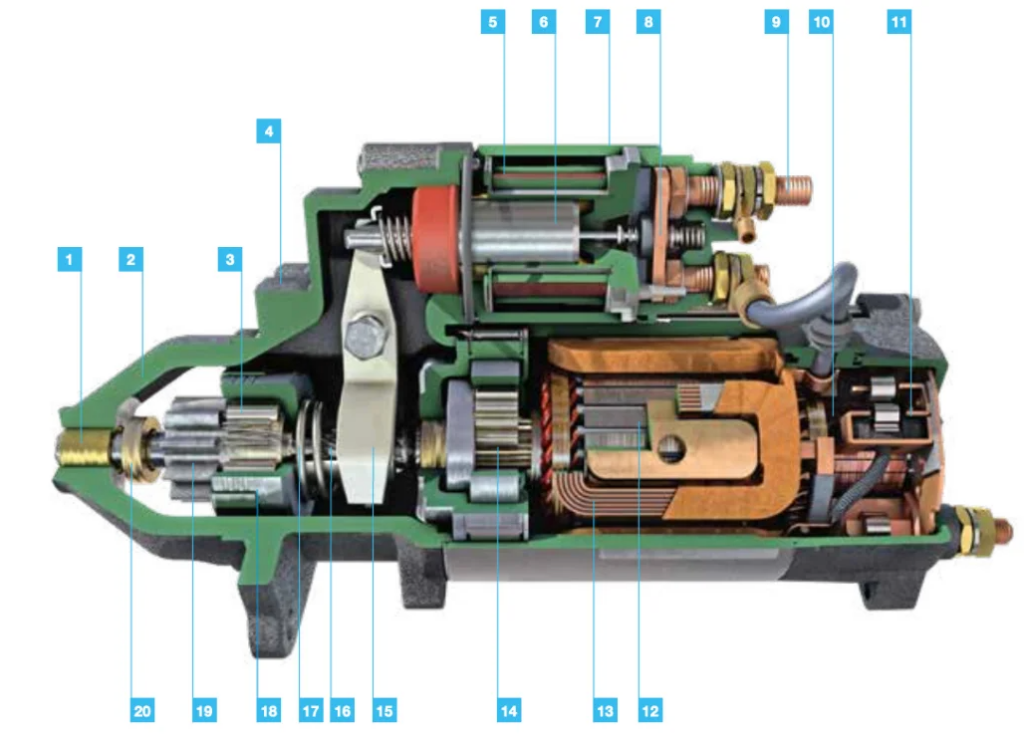
- Location of pinion shaft
- Flange
- Rolling element of freewheel clutch
- Mounting flange
- Solenoid coil
- Plunger
- Solenoid
- Contact bridge
- Battery connection
- Commutator
- Carbon brush
- Armature
- Pole winding
- Reduction gear
- Engaging fork
- Helix
- Meshing spring
- Freewheel clutch
- Pinion
- Stop ring
Armature
The armature, or motor to everyday folks, sits at the heart of the starter. It’s a cylindrical iron or steel core surrounded by copper wire coils. When current from the battery goes through the armature, it makes a magnetic field that interacts with the field from the permanent magnets in the starter. This interaction makes the armature spin.
Commutator
The commutator is a part on the armature. It’s made of copper segments separated by insulation. The commutator’s main job is to keep the current flowing through the armature coils always moving one way. This is key to the armature spinning smoothly and efficiently.
Brushes
The brushes are small carbon blocks mounted on the starter housing. They touch the commutator to transfer current to the armature coils. The brushes need replacing periodically since they wear down over time from rubbing the commutator.
Solenoid
The solenoid is an electromagnetic switch that engages the starter gear with the flywheel. When the ignition switch turns on, it sends power to the solenoid, which pulls in a plunger. The plunger meshes the starter gear with the flywheel, and the starter motor starts turning.
Pinion Gear
The starter drive is a small gear on the starter motor. It fits together with the engine’s flywheel and cranks it over. If your starter drive is damaged or worn out, you’ll probably have trouble starting your car.
What Are Terminals On The Starter?
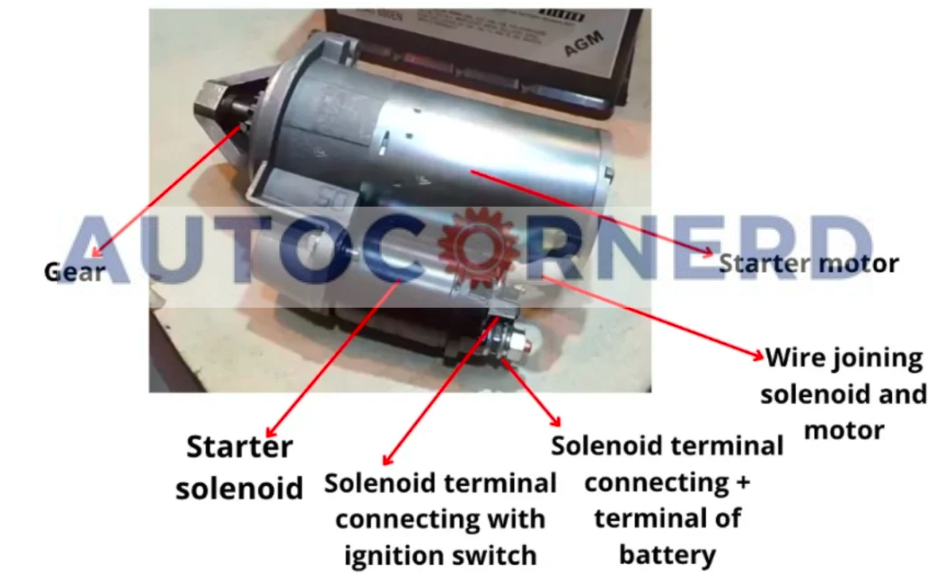
The starter has some common terminals that connect it to the electrical system. Understanding their function helps in diagnosing issues.
The Battery Terminal
The largest terminal on the starter is the battery terminal, also called the B terminal. It links to the positive battery cable, supplying power to crank the engine. This thick cable bolts onto the bottom of the starter.
The Solenoid Terminal
The S or solenoid terminal is the smallest. It controls the solenoid when the ignition key turns. The wire from the ignition switch connects here, sending a signal that engages the starter motor.
The Motor Terminal
This M terminal wires the starter motor itself. When the solenoid gets current, it flows through here to the motor, meshing it with the flywheel to spin the engine.
The Ground Terminal
Some starters also have a fourth, separate ground terminal. Often, the starter grounds through its casing bolted to the engine block. But an extra ground terminal completes the circuit on starters with four connections. It is typically the smallest terminal, usually on top.
| Terminal | Name | Cable Size | Cable Color | Explanation |
| 1 | Battery | Thick | Red | Connects the starter to the battery’s positive terminal. |
| 2 | Solenoid | Small | Red (may vary, depending on make and model) | Controls the starter solenoid and receives signal from the ignition switch. |
| 3 | Motor | Small | Blue, white, or black | Connects the starter motor to the solenoid and turns over the engine. |
| 4 | Ground | Small | Black | Connects the starter to the vehicle’s ground system to complete the electrical circuit necessary to start the engine. Not found on all starters. |
3 Pole Starter Wiring Diagram
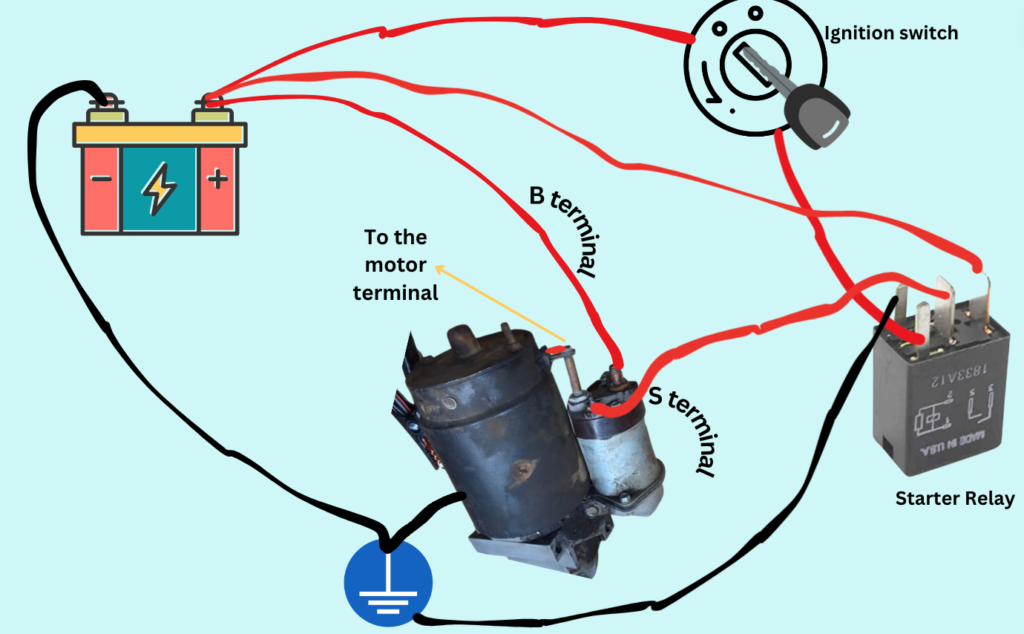
Note: In the above picture, you can see that I have shown all wires except the ground wire in red color. The red color represents hot. So, the thick cable from the battery will always be red in color.
In this diagram, the battery is connected to the solenoid via a positive cable. The solenoid has three terminals: the battery terminal, the starter terminal, and the ignition switch terminal.
The control circuit is connected to the ignition switch terminal of the solenoid. When the ignition key is turned, the control circuit sends a signal to the solenoid, which activates the coil.
The coil of the solenoid pulls the contacts together, connecting the battery to the starter motor. This causes the starter motor to turn over the engine and start the vehicle.
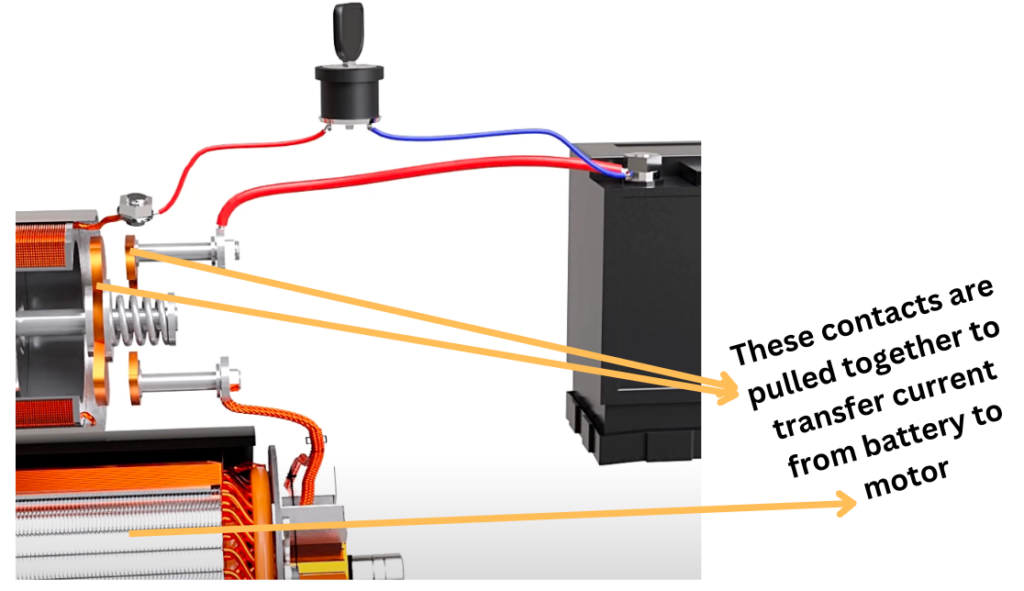
3 Pole Starter Solenoid Wiring Diagram
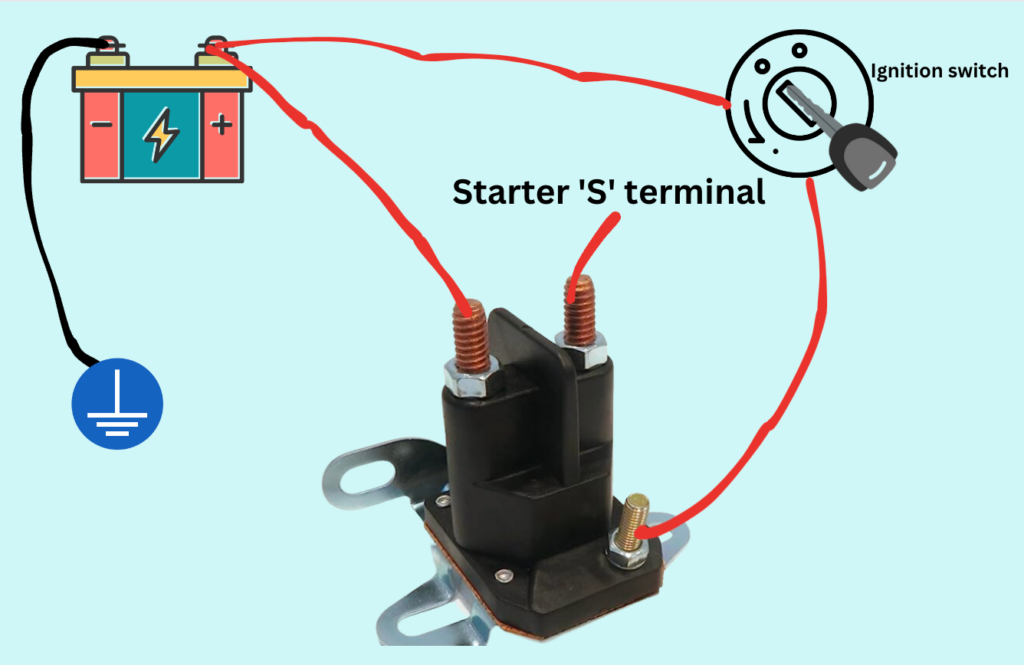
The starter relay (also called starter solenoid) is the key that powers up your engine. This component completes the circuit between your battery and starter motor, funneling the high current needed to crank the engine. Without the starter relay, turning the key would simply burn up your ignition switch.
When you turn the ignition key, a small electric current flows into the relay’s input coil. This creates a magnetic field that throws an internal switch, connecting the battery power to the starter solenoid.
The relay’s main job is to protect your delicate ignition switch. It redirects the heavy starter current around the switch, instead routing it straight from the battery to starter. This prevents electrical overload that would eventually destroy the ignition switch contacts.
A mechanical analogy helps explain the starter relay design. Think of the coil as a “gatekeeper” that must be energized to open the circuit “gate.” The ignition key current unlocks the gatekeeper. Once energized, it throws the internal power switch that connects battery to starter.
The relay coil requires only a tiny control current, but can handle 100+ amps through its output contacts. This allows a low current circuit to control a high current circuit safely.
4 Pole Starter Solenoid Wiring Diagram Chevy
In 4 pole starter solenoid, the mounting base is insulated, due to which there is a separate terminal for the ground connection. On the other hand, the 3-post starter requires a good bright mounting surface to ground.
In a 4 pole starter solenoid, the ground connection is achieved by attaching a grounding wire to one of the starter terminals, which then connects to the chassis.
Some people also call a starter relay a starter solenoid. But, in literature, the starter solenoid is the component that is fixed to the starter motor. I will discuss more about this later in this guide.
The starter solenoid (the one attached to the starter motor) can be assumed as a larger relay to supply current to the starter motor.
On the other hand, a starter relay is used to supply current from the ignition switch to the starter solenoid.
Like a starter, a starter solenoid (also called starter relay as I said above) can also have 4 terminals in addition to a ground terminal. That fourth terminal is labeled as ‘I’ or ‘R’ terminal.
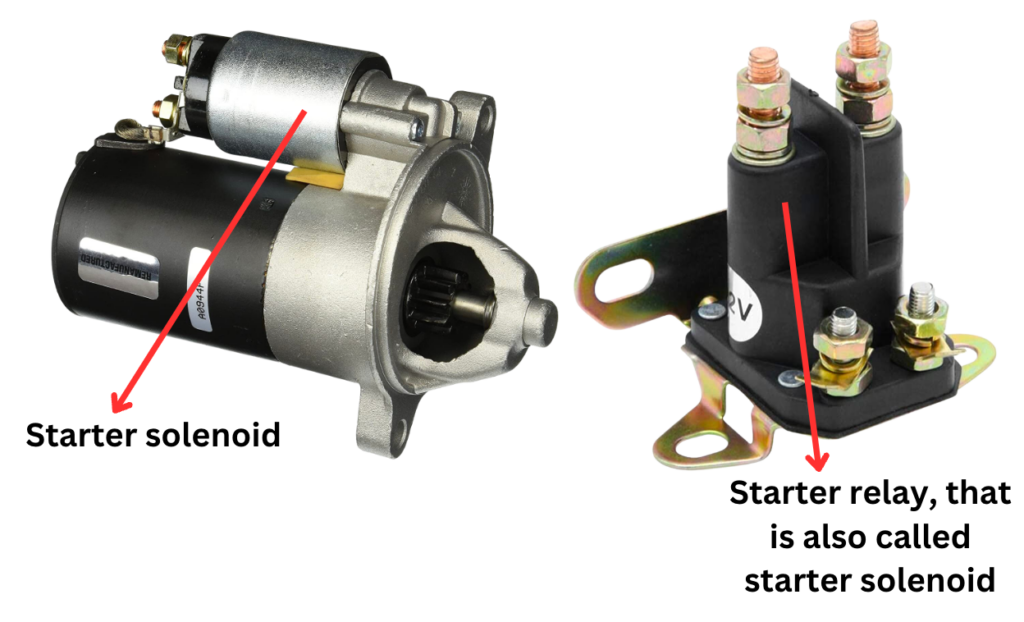
In the picture above, one big terminal of the starter relay is connected to the positive terminal of the battery, and the other big post of the relay is connected to the S terminal of the starter.
Of the two small terminals on a relay, one is connected to the ignition switch and the other is considered as ‘I’ or ‘R’ terminal. That terminal delivers a full 12 volts to the ignition coil for a hotter spark when starting.
You can watch following video to get an idea how starter relay is connected toi the starter:
How To Test Starter If Car Is Not Starting?
Cars keep their starters in different spots. For some, it’s down below the engine. For others, it’s close to the engine block under the hood.
Once you get the starter out, you can see if it’s doing its job. A good starter has two key pieces.
One is the solenoid. When it works, the starter gear can pop out to reach the flywheel. The second is the motor that spins that gear. If both spin together, your flywheel turns too. That starts up your engine.
You can watch the following video to test a starter:
You can also read my guide on car making whirring noise due to bad starter.
